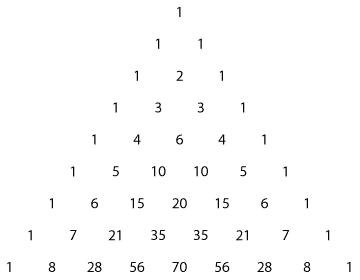4.2 Binomial expansion
A binomial has the form \((a+b)^n\). When \(n\) is a positive integer, it can be expanded according to this formula:
\((a+b)^n = \dbinom{n}{0} a^n b^0 + \dbinom{n}{1} a^{n-1} b^1 + \dbinom{n}{2} a^{n-2} b^2 + ... + \dbinom{n}{n-1} a^1 b^{n-1} + \dbinom{n}{n} a^n b^0\)
Pascal's Triangle
The coefficients of the binomial expansion form a pattern known as Pascal's Triangle. (The first row is the 0th row.)

For example, the 4th row of the triangle shows the coefficients for the expansion of \((a+b)^4\).
For high powers of \(n\), it is quicker to use the \(^nC_r\) method for finding the coefficients, because it takes a while to write out Pascal's Triangle.
Uses of the binomial expansion
The binomial expansion can be used for approximations and calculating binomial probabilities.
\((a+b)^n = \dbinom{n}{0} a^n b^0 + \dbinom{n}{1} a^{n-1} b^1 + \dbinom{n}{2} a^{n-2} b^2 + ... + \dbinom{n}{n-1} a^1 b^{n-1} + \dbinom{n}{n} a^n b^0\)
Pascal's Triangle
The coefficients of the binomial expansion form a pattern known as Pascal's Triangle. (The first row is the 0th row.)

For example, the 4th row of the triangle shows the coefficients for the expansion of \((a+b)^4\).
For high powers of \(n\), it is quicker to use the \(^nC_r\) method for finding the coefficients, because it takes a while to write out Pascal's Triangle.
Uses of the binomial expansion
The binomial expansion can be used for approximations and calculating binomial probabilities.
Important
Binomial expansion
\((a+b)^n = \dbinom{n}{0} a^n b^0 + \dbinom{n}{1} a^{n-1} b^1 + \dbinom{n}{2} a^{n-2} b^2 + ... + \dbinom{n}{n-1} a^1 b^{n-1} + \dbinom{n}{n} a^n b^0\)
\((a+b)^n = \dbinom{n}{0} a^n b^0 + \dbinom{n}{1} a^{n-1} b^1 + \dbinom{n}{2} a^{n-2} b^2 + ... + \dbinom{n}{n-1} a^1 b^{n-1} + \dbinom{n}{n} a^n b^0\)
3